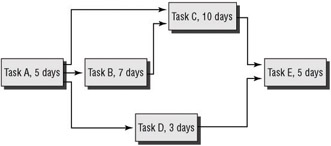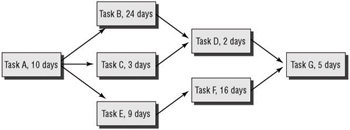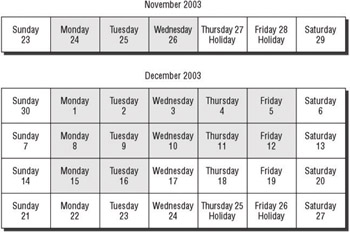Review Questions
| 1. | Which is true for the critical path ?
| |
| 2. | You are a project manager for a major movie studio. You need to schedule a shoot in Denver during ski season . This is an example of which of the following?
| |
| 3. | What is analogous estimating also referred to as?
| |
| 4. | You are working on your network diagram. Task A is a predecessor to Task B. Task B cannot begin until Task A is completed. What is this telling you?
| |
| 5. | What is the most commonly used form of network diagramming?
| |
| 6. | What are crashing and fast track techniques used for?
| |
| 7. | Which is true for float or slack time?
| |
| 8. | Which of the following is not a tool used to determine a project critical path?
| |
| 9. | Activity B on your network diagram has a duration of 8 days. How do you calculate the early finish date for this task?
| |
| 10. | Which of the following is true for all activities on the critical path?
| |
| 11. | You're working on a project in which the time to complete the project has been heavily restricted and funds are short. Part of the project consists of your server administrator preparing a halfdozen servers for use in a balanced web array. The servers will all look basically alike. What technique can you use to slim down some of the time required to perform this task in the project?
| |
| 12. | Why is it important to understand the critical path of a project?
| |
| 13. | Suppose that you're working on a project in which you've established this milestone: 'Database Servers Built and Functional.' The following tasks are needed to get to this milestone: a. Build 3 database servers-see published burn doc b. Install Oracle 9i on each server c. Validate that Oracle is running correctly and can be connected to d. Install database schemas from development environment - see schema build documentation e. Test 100% succesful Which of the tasks above would represent entry criteria for the milestone?
| |
| 14. | You're working on a project that you and your team have estimated is going to take 15 business days. Given the work calendar shown below with a start date of Monday, November 24, 2003, how many calendar days are actually required? 
| |
| 15. | A milestone differs from a task in that it (Select all that apply):
| |
| 16. | You're in the process of developing a project schedule for a new project in which you've just completed the requirement-gathering and scope document elements. What would be the smart next step in figuring out what tasks go into the project schedule?
| |
| 17. | You've defined a task in a project schedule in which your team members will develop an XML application that uses a MySQL back end. While the DBA has plenty of experience with Oracle and MS SQL Server, he's pretty new to MySQL. What is the most likely element affected in the tasks of your project schedule?
| |
| 18. | You're the project manager for a project in which you're following a specific software development methodology. Some of the developers have observed that a new coding technique could improve the speed with which the code will be developed and ready. How will this affect the current activity duration for the project?
| |
| 19. | The exhibit shows the steps in a network diagram. Task B must occur before Task C. Tasks B, C, and D must all occur after Task A and must all occur before Task E can be accomplished. How long is the critical path, in days? 
| |
| 20. | The exhibit shows a series of steps in a network diagram. Tasks B through F must all wait for Task A to be completed and must all be complete before Task G can begin. Tasks B and C must occur before Task D, and Task E must occur before Task F. How long is the critical path, in days? 
| |
Answers
| 1. | C. The critical path is the longest activity sequence in the network. It has zero float or slack time, and it controls the project end date. |
| 2. | A. A dependency such as weather conditions or a specific season that is outside the list of project activities is an external dependency. A finish to finish relationship means that the successor task cannot finish until the predecessor task completes. A mandatory dependency is created by the nature of the work. |
| 3. | D. Analogous estimating is also called top down estimating. It is used early in the project when there is not enough detail to do a detailed estimate. The estimate is done based on a similar project. Expert judgement relies on people most familiar with the tasks to complete the estimates. Fast tracking and crashing are forms of duration compression. |
| 4. | B. There is a finish to start dependency relationship between Task A and Task B. You do not have enough information to determine if the dependency between the two tasks is mandatory, discretionary, or external. |
| 5. | B. Precedence diagramming is the most used diagramming method. Activity on arrow is a less-used diagramming method that uses arrows to represent the tasks. CPM is a schedule-development technique. Although network diagrams are sometimes called PERT charts , PERT is actually a seldom-used, specialized schedule-development technique that uses weighted averages. |
| 6. | A. Duration compression involves either crashing the schedule by adding more resources or creating a fast track by working activities in parallel that would normally be done in sequence. Activity sequencing is the process of determining the order in which tasks must be worked. Precedence diagramming method, the most common form of the network diagram, is a depiction of the project activities and the interrelationships among these activities. Activity definition is the process of defining all the tasks required to complete the project deliverables. |
| 7. | C. Float or slack time is the time a task may be started late or the additional duration a task may use without impacting project completion. |
| 8. | B. The tools use to calculate critical path are forward pass, backward pass, and float calculation. Duration compression is a technique used in schedule development. |
| 9. | C. Early finish is calculated by adding Activity B's task duration to its early start date. |
| 10. | D. The late finish is always the same as the early finish. Float is always zero on the critical path activities. The critical path is always the longest path on the network diagram. |
| 11. | A. You only have one admin, so crashing the project (bringing in multiple folks to parallel tasks) probably isn't the solution. You can't reduce the number of servers-ostensibly because by the time you've gotten to this step in the project, requirement-gathering has illustrated that you will need this many. Purchasing a VM server probably won't help because it's as complex to bring up as the six individual servers, what with the underlying VM software and the individual partitions. |
| 12. | B. Tasks on the critical path aren't necessarily the most important, they're just the ones that have zero float time-meaning you have no wiggle room from start to finish. Because of that, the tasks on the critical path should, if represented well, represent the actual complete duration of the project. Tasks on the critical path don't necessarily have to be done first-but they must be done in the order that you've defined with their predecessors and successors. Once you've defined the tasks and figured out what the critical path is (and obtained sign-off) you don't want to add tasks to it because this represents scope slippage. |
| 13. | E. Building the servers, installing Oracle on them, and bringing up the schemas represents work toward the milestone, but does not adequately represent that you've reached the milestone. Only task e, which says that you've successfully tested the servers as database servers, indicates that you've reached your goal. |
| 14. | C. As you can see from the answer graphic, you have to count the Saturdays and Sundays plus the holidays that are included in the project's calendar days. Even though the project only takes 15 days, you'll require 23 to account for days off.  |
| 15. | A, B, E. The 2000 Guide to the PMBOK (glossary-page 203) says that a milestone is a representation of a significant event in the project-often the production of a major project deliverable . Therefore, when you shift from one project phase to another in your WBS, representing the completion of a group of tasks that resulted in that phase completion, or you've completed all the deliverables and you've now shifted from the Executing/Controlling to the Closing process group, you have achieved a milestone. There is a lot of room for gray area discussion about what actually makes up a milestone in any given project-it's fundamental that you would arrive at those milestone designations by communicating with your team to determine what the milestones are and then communicate outward to your stakeholders. All interested parties should know when you've hit a key milestone. |
| 16. | D. As a result of finishing the scope document and requirements documents, you probably already know who's going to be on the project team. What you don't have a good feel for, at least yet, is the tasks that have to be done. A white board and sticky note session with your project team would be a good starting point in directing you to a network diagram that ( hopefully) everyone can live with. |
| 17. | B. As an experienced DBA, he probably has the ability to give you a fairly good estimate of what it's going to take to build the database in MySQL. Much of the design work in databases is done before the DBA hits the UI ( user interface) to actually create the tables so you can be reasonably sure of the estimate of work. However, that being said, you cannot stipulate for positive the duration of the task. |
| 18. | A. Here's the wrinkle with such a proposal: The developers are smart enough to understand that the amount of time required to write the new programs will be diminished by adopting this new software development methodology; however, how long will it take them to fully envelop the new principles of this methodology? In other words, if you're used to doing a thing a certain way-in fact you've been doing it that way for a long time-and then you learn a new, faster way, how long does it take you to integrate the new method into your skill set? As a project manager, you have to somehow figure out the delta in the two (the difference between the improvement in coding speed versus the time required to adopt the new methodology). If there's a significant difference, then it's probably worth your while to adopt the new technique. |
| 19. | C. The critical path is the series of consecutive activities that represent the longest necessary path through the network diagram. You use up 5 days with Task A, then 7 days with B, 10 days with C, and a final 5 days with Task E, for a total of 27 days. Even though Task D cannot fire off before Task A is completed, A-D-E only uses 13 days. |
| 20. | C. Tasks A, B, D, and G represent the longest dependent path through the network diagram, so the critical path requires 41 days. |
EAN: 2147483647
Pages: 156